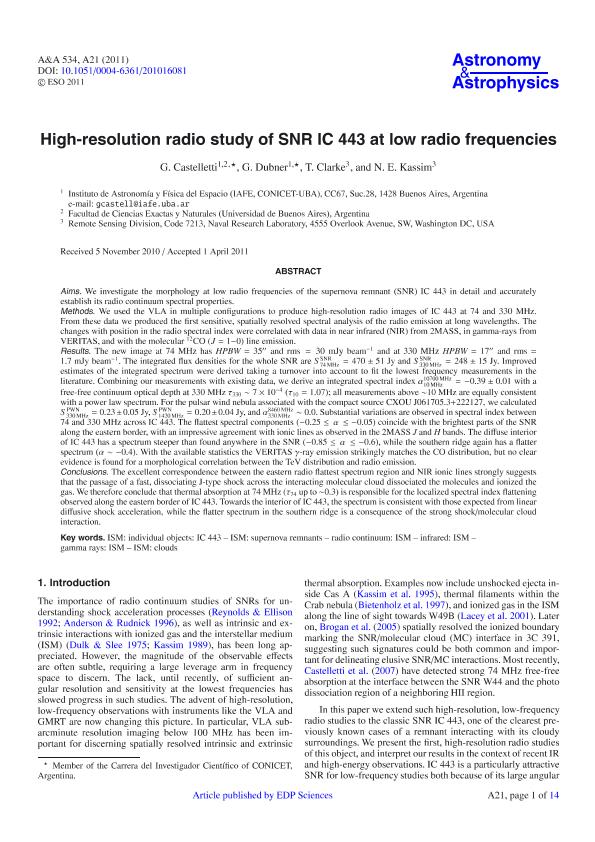Mostrar el registro sencillo del ítem
dc.contributor.author
Castelletti, Gabriela Marta

dc.contributor.author
Dubner, Gloria Mabel

dc.contributor.author
Clarke, T.
dc.contributor.author
Kassim, N. E.
dc.date.available
2017-07-06T20:33:22Z
dc.date.issued
2011-04
dc.identifier.citation
Castelletti, Gabriela Marta; Dubner, Gloria Mabel; Clarke, T.; Kassim, N. E.; High-resolution radio study of SNR IC443 at low radio frequencies; EDP Sciences; Astronomy and Astrophysics; 534; A21; 4-2011; 1-14
dc.identifier.issn
0004-6361
dc.identifier.uri
http://hdl.handle.net/11336/19818
dc.description.abstract
Aims. We investigate the morphology at low radio frequencies of the supernova remnant (SNR) IC 443 in detail and accurately establish its radio continuum spectral properties. Methods. We used the VLA in multiple configurations to produce high-resolution radio images of IC 443 at 74 and 330 MHz. From these data we produced the first sensitive, spatially resolved spectral analysis of the radio emission at long wavelengths. The changes with position in the radio spectral index were correlated with data in near infrared (NIR) from 2MASS, in gamma-rays from VERITAS, and with the molecular 12CO (J = 1 − 0) line emission. Results. The new image at 74 MHz has HPBW = 35′′ and rms = 30 mJy beam-1 and at 330 MHz HPBW = 17′′ and rms = 1.7 mJy beam-1. The integrated flux densities for the whole SNR are Jy and Jy. Improved estimates of the integrated spectrum were derived taking a turnover into account to fit the lowest frequency measurements in the literature. Combining our measurements with existing data, we derive an integrated spectral index with a free-free continuum optical depth at 330 MHz τ330 ~ 7 × 10-4 (τ10 = 1.07); all measurements above ~ 10 MHz are equally consistent with a power law spectrum. For the pulsar wind nebula associated with the compact source CXOU J061705.3+222127, we calculated Jy, Jy, and . Substantial variations are observed in spectral index between 74 and 330 MHz across IC 443. The flattest spectral components ( − 0.25 ≤ α ≤ − 0.05) coincide with the brightest parts of the SNR along the eastern border, with an impressive agreement with ionic lines as observed in the 2MASS J and H bands. The diffuse interior of IC 443 has a spectrum steeper than found anywhere in the SNR ( − 0.85 ≤ α ≤ − 0.6), while the southern ridge again has a flatter spectrum (α ~ −0.4). With the available statistics the VERITAS γ-ray emission strikingly matches the CO distribution, but no clear evidence is found for a morphological correlation between the TeV distribution and radio emission. Conclusions. The excellent correspondence between the eastern radio flattest spectrum region and NIR ionic lines strongly suggests that the passage of a fast, dissociating J-type shock across the interacting molecular cloud dissociated the molecules and ionized the gas. We therefore conclude that thermal absorption at 74 MHz (τ74 up to ~0.3) is responsible for the localized spectral index flattening observed along the eastern border of IC 443. Towards the interior of IC 443, the spectrum is consistent with those expected from linear diffusive shock acceleration, while the flatter spectrum in the southern ridge is a consequence of the strong shock/molecular cloud interaction.
dc.format
application/pdf
dc.language.iso
eng
dc.publisher
EDP Sciences

dc.rights
info:eu-repo/semantics/openAccess
dc.rights.uri
https://creativecommons.org/licenses/by-nc-sa/2.5/ar/
dc.subject
Ism: Individual Objects: Ic 443
dc.subject
Ism: Supernova Remnants
dc.subject
Radio Continuum: Ism
dc.subject
Infrared: Ism
dc.subject.classification
Astronomía

dc.subject.classification
Ciencias Físicas

dc.subject.classification
CIENCIAS NATURALES Y EXACTAS

dc.title
High-resolution radio study of SNR IC443 at low radio frequencies
dc.type
info:eu-repo/semantics/article
dc.type
info:ar-repo/semantics/artículo
dc.type
info:eu-repo/semantics/publishedVersion
dc.date.updated
2017-07-06T13:03:17Z
dc.journal.volume
534
dc.journal.number
A21
dc.journal.pagination
1-14
dc.journal.pais
Francia

dc.journal.ciudad
Paris
dc.description.fil
Fil: Castelletti, Gabriela Marta. Consejo Nacional de Investigaciónes Científicas y Técnicas. Oficina de Coordinación Administrativa Ciudad Universitaria. Instituto de Astronomía y Física del Espacio. - Universidad de Buenos Aires. Facultad de Ciencias Exactas y Naturales. Instituto de Astronomía y Física del Espacio; Argentina
dc.description.fil
Fil: Dubner, Gloria Mabel. Consejo Nacional de Investigaciónes Científicas y Técnicas. Oficina de Coordinación Administrativa Ciudad Universitaria. Instituto de Astronomía y Física del Espacio. - Universidad de Buenos Aires. Facultad de Ciencias Exactas y Naturales. Instituto de Astronomía y Física del Espacio; Argentina
dc.description.fil
Fil: Clarke, T.. Spece Sciences División. Naval Research Laboratory; Estados Unidos
dc.description.fil
Fil: Kassim, N. E.. Spece Sciences División. Naval Research Laboratory; Estados Unidos
dc.journal.title
Astronomy and Astrophysics

dc.relation.alternativeid
info:eu-repo/semantics/altIdentifier/doi/http://dx.doi.org/10.1051/0004-6361/201016081
dc.relation.alternativeid
info:eu-repo/semantics/altIdentifier/url/https://arxiv.org/abs/1104.0205
dc.relation.alternativeid
info:eu-repo/semantics/altIdentifier/url/https://www.aanda.org/articles/aa/full_html/2011/10/aa16081-10/aa16081-10.html
Archivos asociados
